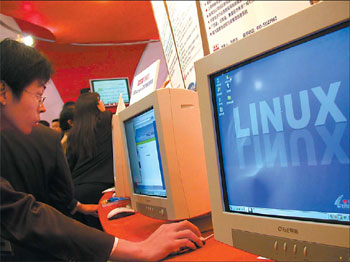

Novell and Red Hat, both based in the United States, are to the Linux operating system what KFC and McDonald's are to fast food: they dominate the market despite numerous small outlets. But a group of fledgling Asian software makers is now using a franchising approach to build a new mainstream Linux brand in Asia.
In September, the Vietnamese software company VietSoftware agreed to join the Asianux Co-development Project, the fourth software maker embracing the movement to create a mainstream Linux operating system in Asia.
The project was begun by China's Red Flag Software and Japan's Miracle Linux in 2003, and attracted South Korea's Haansoft a year later. The three companies agreed to co-develop a Linux operating system under the brand Asianux, sharing the system's software kernel and key components to allow further development for their regional markets.

The three established a 30-person research center in Beijing that has helped roll out localized Linux versions. Each company also has its own development center at home, which working together give Asianux a support team of more than 90 people in China, Japan and South Korea.
"The Asianux project model does look like franchising," says Geng Zengqiang, product and marketing director of Red Flag Co Ltd. "Asianux members share research and development costs and become the sole distributor in their home nations."
VietSoftware, like the other three companies, will contribute to the Asianux development center in Beijing. It will also establish its own center in Vietnam to localize the interface of the operating system and release products for its home market. It enables VietSoftware, before an outsourcing service provider, to make a shortcut into the Linux market.
Even as a founding member of Asianux, Red Flag doesn't seem to benefit directly from expansion of the project. All Asianux member companies are required to stay in their home countries to avoid competition with one another.
It prevents Red Flag from expanding overseas, but that might fit its plans. It is already the largest Linux software supplier in China, holding slightly more market share than its competitors Novell and Red Hat.
And it does believe it has an edge - major computer companies have tested and certified that its operating system is compatible with their hardware and systems.
"The success of a Linux operating system largely relies on the support from other hardware and software companies," says Geng.
Linux systems are now most widely used on computer servers, a market that generates more than 70 percent of Red Flag's current sales revenue. But that requires computer makers like IBM, HP and Dell to spend millions of dollars to test the compatibility between operating systems and their servers.
"Seeing Asianux's potential to be a major Linux standard in Asia, IBM has spent hundreds of millions of dollars to certify Red Flag's products," says Geng, adding Asianux has obtained support from other major global IT companies including Intel and SAP.
"Despite its leading position in China, Red Flag is still small compared with Red Hat and Novell. Let alone Microsoft," says Geng. "Without Asianux, we would need to set up our own shops in different nations to gain a critical number of users, which is beyond our reach."
Red Flag claims to be the largest Linux developer in Asia with a support team of more than 150 people and 40 million yuan in sales revenue in 2006. In contrast, Red Hat registered more than $400 million in sales last year.
"But if you look at Asianux as one company, it now has the largest team in China, South Korea and Japan, which allows it to compete with the Red Hat and Novell in those regional markets," says Geng.
The idea of Asianux has had a positive reception from other countries as well. "Like China, other Asian countries are also eager to find less expensive operating systems as an alternative to Microsoft's products and cultivate their own software giants"
Vietnam has been one of the most aggressive in joining the open source trend. As early as 2004, the nation had already mapped out its first master plan for developing open source software from 2004 to 2008. Vietnam's ministry of science and technology joined the Asianux advisory board in July and then recommended six Vietnamese software companies as candidates for cooperation with Asianux.
"Vietnam is still a developing country and needs low-cost software to help the development of its IT industry," says Nguyen Trung Quynh, director of the Project Management Board on Vietnam open source software under the Ministry of Science and Technology. "Cooperation between Vietnam and the Asianux consortium would help accelerate the development and use of open source software in the nation."
The Southeast Asia country joined the World Trade Organization in 2007 and made commitments to protect intellectual property. Lower-cost software could be an important way for the nation to combat piracy, says Nguyen.
Linux seems to be gaining steam globally.
US research firm IDC says that the global market for Linux will enjoy an average annual growth of 25.9 percent between 2003 and 2008 and the market value will exceed $35 billion by the end of next year.
China's Linux software market expanded by 27.3 percent in 2006 to $163 million last year, according to CCID Consulting, a local researcher.
"Next year the Asianux consortium will recruit at least two more countries and then cover more than six Asia countries," says Geng. "By the end of 2009, Asianux may have the largest Linux market in Asia."
(China Daily 10/15/2007 page7)













